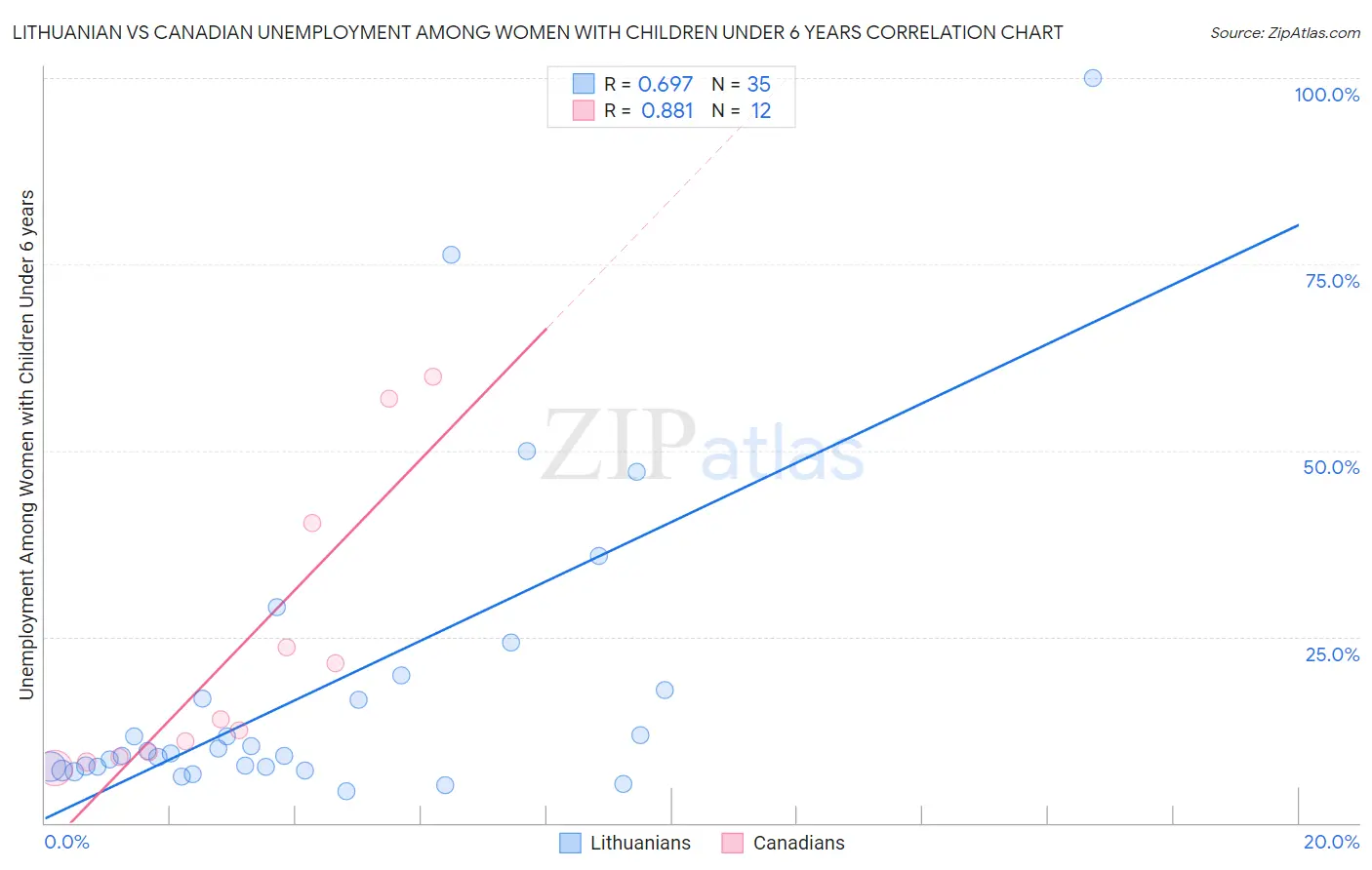Lithuanian vs Canadian Unemployment Among Women with Children Under 6 years
COMPARE
Lithuanian
Canadian
Unemployment Among Women with Children Under 6 years
Unemployment Among Women with Children Under 6 years Comparison
Lithuanians
Canadians
7.8%
UNEMPLOYMENT AMONG WOMEN WITH CHILDREN UNDER 6 YEARS
30.0/ 100
METRIC RATING
198th/ 347
METRIC RANK
7.8%
UNEMPLOYMENT AMONG WOMEN WITH CHILDREN UNDER 6 YEARS
20.6/ 100
METRIC RATING
207th/ 347
METRIC RANK
Lithuanian vs Canadian Unemployment Among Women with Children Under 6 years Correlation Chart
The statistical analysis conducted on geographies consisting of 306,238,361 people shows a significant positive correlation between the proportion of Lithuanians and unemployment rate among women with children under the age of 6 in the United States with a correlation coefficient (R) of 0.697 and weighted average of 7.8%. Similarly, the statistical analysis conducted on geographies consisting of 318,159,261 people shows a very strong positive correlation between the proportion of Canadians and unemployment rate among women with children under the age of 6 in the United States with a correlation coefficient (R) of 0.881 and weighted average of 7.8%, a difference of 0.82%.

Unemployment Among Women with Children Under 6 years Correlation Summary
| Measurement | Lithuanian | Canadian |
| Minimum | 4.2% | 7.4% |
| Maximum | 100.0% | 59.9% |
| Range | 95.8% | 52.5% |
| Mean | 18.0% | 22.8% |
| Median | 9.3% | 13.2% |
| Interquartile 25% (IQ1) | 7.5% | 9.2% |
| Interquartile 75% (IQ3) | 17.9% | 31.9% |
| Interquartile Range (IQR) | 10.4% | 22.7% |
| Standard Deviation (Sample) | 20.9% | 19.1% |
| Standard Deviation (Population) | 20.6% | 18.3% |
Demographics Similar to Lithuanians and Canadians by Unemployment Among Women with Children Under 6 years
In terms of unemployment among women with children under 6 years, the demographic groups most similar to Lithuanians are Italian (7.7%, a difference of 0.030%), Immigrants from St. Vincent and the Grenadines (7.7%, a difference of 0.080%), Malaysian (7.7%, a difference of 0.090%), Syrian (7.7%, a difference of 0.15%), and Slavic (7.7%, a difference of 0.18%). Similarly, the demographic groups most similar to Canadians are Hungarian (7.8%, a difference of 0.060%), Immigrants (7.8%, a difference of 0.070%), Lebanese (7.8%, a difference of 0.15%), Immigrants from Syria (7.8%, a difference of 0.18%), and Spaniard (7.8%, a difference of 0.26%).
| Demographics | Rating | Rank | Unemployment Among Women with Children Under 6 years |
| Immigrants | Africa | 32.4 /100 | #192 | Fair 7.7% |
| Slavs | 32.4 /100 | #193 | Fair 7.7% |
| Syrians | 31.9 /100 | #194 | Fair 7.7% |
| Malaysians | 31.1 /100 | #195 | Fair 7.7% |
| Immigrants | St. Vincent and the Grenadines | 31.1 /100 | #196 | Fair 7.7% |
| Italians | 30.4 /100 | #197 | Fair 7.7% |
| Lithuanians | 30.0 /100 | #198 | Fair 7.8% |
| Immigrants | Poland | 27.3 /100 | #199 | Fair 7.8% |
| Guamanians/Chamorros | 25.5 /100 | #200 | Fair 7.8% |
| Basques | 24.7 /100 | #201 | Fair 7.8% |
| Sudanese | 23.5 /100 | #202 | Fair 7.8% |
| Spaniards | 23.3 /100 | #203 | Fair 7.8% |
| Lebanese | 22.2 /100 | #204 | Fair 7.8% |
| Immigrants | Immigrants | 21.4 /100 | #205 | Fair 7.8% |
| Hungarians | 21.2 /100 | #206 | Fair 7.8% |
| Canadians | 20.6 /100 | #207 | Fair 7.8% |
| Immigrants | Syria | 18.9 /100 | #208 | Poor 7.8% |
| Costa Ricans | 17.6 /100 | #209 | Poor 7.8% |
| Poles | 16.0 /100 | #210 | Poor 7.9% |
| Immigrants | Ecuador | 14.9 /100 | #211 | Poor 7.9% |
| Swiss | 12.3 /100 | #212 | Poor 7.9% |